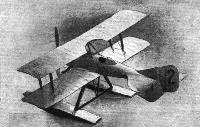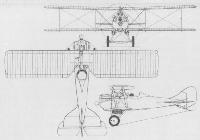W.Green, G.Swanborough The Complete Book of Fighters
NIEUPORT 29 France
Flown for the first time early in June 1918, the Nie 29 combined several features previously tested by Gustave Delage on earlier prototype fighters. A nominally staggered two-bay equi-span biplane powered by a 300 hp Hispano-Suiza 8Fb eight-cylinder water-cooled engine and carrying an armament of two 7,7-mm Vickers guns, the Nie 29 featured a wooden monocoque fuselage (thin tulip wood strips glued in spirals in alternating directions) and fabric-covered wings. An initial series order on behalf of the Aviation Militate was placed in 1920, the first being delivered on 11 February 1921. A variant referred to as the ‘‘Nie 29 Type 22 m2” with wing area reduced by 53.82 sqft (5,00 m2) was displayed at the Salon de l'Aeronautique in December 1922, but did not attract a production contract. Another variant, with a Gnome 9N rotary engine, was identified as the Nieuport 29G. With the death of Louis Nieuport, the Etablissements Nieuport amalgamated with the Astra concern in 1921 to become Nieuport-Astra, and subsequent to the commencement of production deliveries of the Nie 29, Nieuport aircraft were restyled Nieuport-Delage, the new fighter thus becoming the Ni-D 29. The Aviation Militaire strength peaked at 25 escadrilles equipped with this type in 1925. In excess of 250 were built by Nieuport-Astra, Schreck, Levasseur, Potez, Bleriot, Letord, Farman and Buscaylet, the excellent manoeuvrability and sturdiness of the Ni-D 29 attracting considerable foreign attention. Several were exported to Argentina, 21 were supplied to Belgium (where 87 more were built by SABCA), six were delivered as pattern aircraft to Italy (where 80 were built by Caproni and 95 by Macchi) and one as a pattern aircraft to Japan. In this last-mentioned country, no fewer than 608 were built by Nakajima with the designation Ko-4 for the Imperial Army between 1923 and 1932, these remaining in service until 1933, and seeing extensive use during the Manchurian and Shanghai conflicts. Twenty were sold to Spain (where 10 more were licence-built) and nine went to Sweden.
Max speed, 147 mph (236 km/h) at sea level.
Time to 16,405 ft (5 000 m), 14 min.
Endurance, 2.5 hrs.
Empty weight, 1,874 lb (850 kg).
Loaded weight, 2,623 lb (1190 kg).
Span, 31ft 2 in (9,50 m).
Length, 21ft 1 1/2 in (6,44 m).
Height, 8 ft 8 3/4 in (2,66 m).
Wing area, 290.63 sqft (27,00 m2).
R.Mikesh, A.Shorzoe Japanese Aircraft, 1910-1941 (Putnam)
Army Type Ko 4 Fighter
Immediately after the First World War, the Nieuport company introduced it new fighter, the Nieuport 29-C-1, then acclaimed the best fighter in the world, and it became the standard equipment of the Armee de I'Air. The Japanese Army imported some of these fighters in 1923 to replace the Type Hei 1 and Type Ko 3 Fighters as its standard equipment. To provide the additional aircraft necessary, Nakajima procured the licence to manufacture them in Japan, as the Type Ko 4 Fighter.
These aircraft were markedly different in structure from previous Army fighters in that the Nieuport 29-C-1 had a very advanced well streamlined wooden monocoque fuselage.
The first was assembled from imported components in December 1923. Production began with some Japanese modifications and continued until January 1932, 608 being delivered to the Army. It was the Army's first mass-produced fighter, and the lack of changes in its outward appearance from that of the original Nieuport 29-C-1 confirmed its excellent design. The slim fighter had a very smooth skinned fuselage, Lamblin radiator, and dihedral on the upper wing only. Armament consisted of two Vickers 7.7mm machine-guns on top of the forward fuselage. The type entered operational service with Japanese Army units in 1925 and remained as standard equipment until about 1933, being replaced by the Nakajima-built Army Type 91 Fighter.
The Ko 4 was excellent in general performance, but it had peculiarities such as a tendency to slide-slip and stall at speeds greater than normal stalling speed. Many pilots experienced emergency landings because of engine problems and they preferred the earlier Type Ko 3 with the better flying qualities. The wooden monocoque fuselage caused new difficulties when requiring repair.
Type Ko 4 Fighters participated in the Manchurian and Shanghai Incidents, making them the first Japanese fighters to be sent overseas for combat; however, they did not engage the enemy because there was no air opposition. Following their military service life, some were released to civil operators and remained in flying schools until as late as 1937.
Single-engine single-seat single-bay biplane fighter. Wooden monocoque fuselage with fabric-covered wooden wing. Pilot in open cockpit.
300-320hp Mitsubishi-Hispano-Suiza eight-cylinder vee water-cooled engine, driving a two-bladed wooden propeller.
Two forward-firing fixed 7.7mm machine-guns.
Span 9.70m (31ft 9 3/4in); length 6.44m (21ft 1 1/2in); height 2.64m (8ft 8in); wing area 26.80sq m (288.482sq ft).
Empty weight 825kg (1,818Ib); loaded weight 1,160kg (2,557Ib); wing loading 43.3kg/sq m (8.8Ib/sq ft); power loading 3.84kg/hp (48.4Ib/hp).
Maximum speed 126kt (145mph); cruising speed 92kt (106mph); landing speed 50kt (59mph); climb to 4,000m (13,123ft) in 13min 30sec; service ceiling 8,000m (26,246ft); endurance 2hr.
608 built from December 1923 to January 1932.
J.Forsgren Swedish Military Aircraft 1911-1926 (A Centennial Perspective on Great War Airplanes 68)
Nieuport-Delage 29C-1
The last type of airplane to enter service with AFK was the Nieuport-Delage 29C-1. One year prior to the formal establishment of an independent Flygvapnet, Karl A.B. Amundson was appointed as its first Commander-in-Chief. Upon his own initiative, Amundson ordered ten Nieuport-Delage 29C-1’s. Although some criticism was levelled at Amundson, he was well aware that the necessary funds would be forthcoming. The price for the ten airplanes, 175,575 kronor, was considered a bargain. On the same day that Flygvapnet was established, July 1,1926, the government duly paid for the airplanes. Delivery took place between March and May 1926, with the designation J 25 being assigned. The ten Nieuport-Delage 29C-1’s were issued with the serial numbers 63 (c/n 1205), 65 (c/n 1206), 67 (c/n 1207), 69 (c/n 1208), 611 (c/n 1209), 613 (c/n 1210), 615 (c/n 1211), 617 (c/n 1212), 619 (c/n 1213) and 621 (c/n 1214). The Nieuports entered service with 3.Flygkaren (3.Air Corps) at Malmen. One, serial number 67, was destroyed on August 15, 1926, when the engine starter air pressure tube exploded. A conscript mechanic, Karl-Bertil Norman, was killed.
On July 1,1928, the Flygvapnet designation J 2 was assigned to the remaining Nieuports. It is notable that the airplanes remained unarmed until 1927, which meant that their primary use was as advanced trainers. With the manufacturing quality being considered substandard, the J 2’s saw comparatively little use. The last J 2’s were struck off charge in 1930.
Nieuport-Delage 29C-1 Technical Data and Performance Characteristics
Engine: 1 x 300 h.p. Hispano Suiza 8 Fb
Length: 6,50 m
Wingspan: 9,70 m
Height: 2,26 m
Wing area: 26,84 m2
Empty weight: 873 kg
Maximum weight: 1,200 kg
Maximum speed: 220 km/h
Armament: 2 x 6,5 mm machine guns
 |
W.Green, G.Swanborough - The Complete Book of Fighters
|
| An Ni-D 29 of the Escadrille Lafayette, part of the 35 Regiment d'Aviation Mixte.
|
 |
J.Forsgren - Swedish Military Aircraft 1911-1926 /Centennial Perspective/ (68)
|
| Nieuport 29 in Swedish service.
|
 |
J.Forsgren - Swedish Military Aircraft 1911-1926 /Centennial Perspective/ (68)
|
| Nieuport 29 in Swedish service.
|
 |
W.Green, G.Swanborough - The Complete Book of Fighters
|
| The Nie (later Ni-D) 29 was built in substantial numbers in five countries.
|
 |
H.Cowin - Aviation Pioneers /Osprey/
|
| Despite the fact that it emerged far too late to see combat during the war, the Nieuport Ni 29 is of more than passing interest in that it serves to show the French trend towards heavier, more powerful fighters that was fully established by the beginning of 1918. Flown initially in June 1918, the Ni 29 was a big, heavy, two-bay winged biplane that relied on the installed power of its 300hp Hispano-Suiza 8Fb for its performance, rather than its aerodynamics. Despite such criticism, this somewhat inelegant machine had a top level speed of 143mph at sea level, exactly comparable to Germany's best in the shape of the Junkers D I, while the Ni 29's ability to reach 16,405 feet in 14 minutes beat Germany's best climbing fighters, the Siemens-Schuckert D III and D IV.
|
 |
J.Forsgren - Swedish Military Aircraft 1911-1926 /Centennial Perspective/ (68)
|
| Ten Nieuport 29's were taken on charge in the spring of 1926. Note the alternative national insignia, consisting of blue and yellow vertical stripes. Via Arlanda Flygsamlingar
|
 |
J.Forsgren - Swedish Military Aircraft 1911-1926 /Centennial Perspective/ (68)
|
| An excellent view of Nieuport 29 serial number 39. This picture was taken in 1927, when the national insignia had been amended to three black crowns. Via Arlanda Flygsamlingar
|
 |
J.Forsgren - Swedish Military Aircraft 1911-1926 /Centennial Perspective/ (68)
|
| Although a relatively modern design, the Nieuport 29's suffered from poor manufacturing standards, being mostly confined to the advanced trainer role. Via Arlanda Flygsamlingar
|
 |
R.Mikesh, A.Shorzoe - Japanese Aircraft, 1910-1941 /Putnam/
|
| Nakajima Army Type Ko 4 Fighter, a licence-produced Nieuport 29-C-1.
|
 |
R.Mikesh, A.Shorzoe - Japanese Aircraft, 1910-1941 /Putnam/
|
| A rare inflight view of a Nakajima Army Type Ko 4 Fighter.
|
 |
Журнал - Flight за 1919 г.
|
| Schneider Cup: A view of the Nieuport seaplane
|
 |
Журнал - Flight за 1919 г.
|
|
|
 |
W.Green, G.Swanborough - The Complete Book of Fighters
|
|
|














